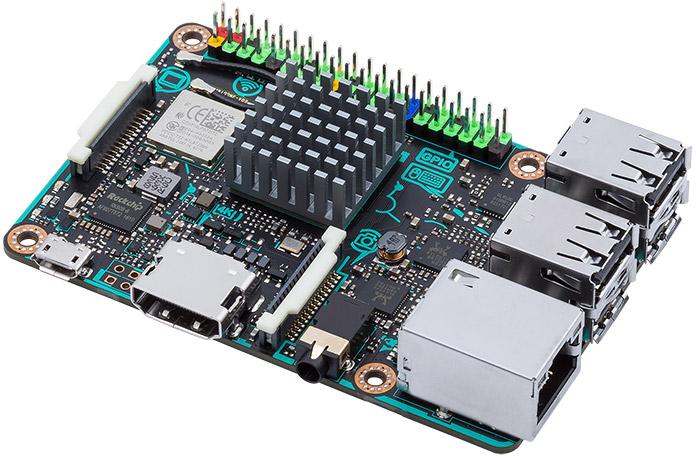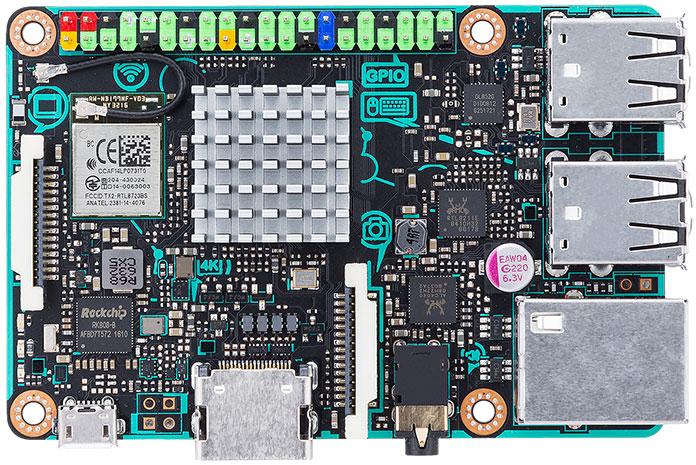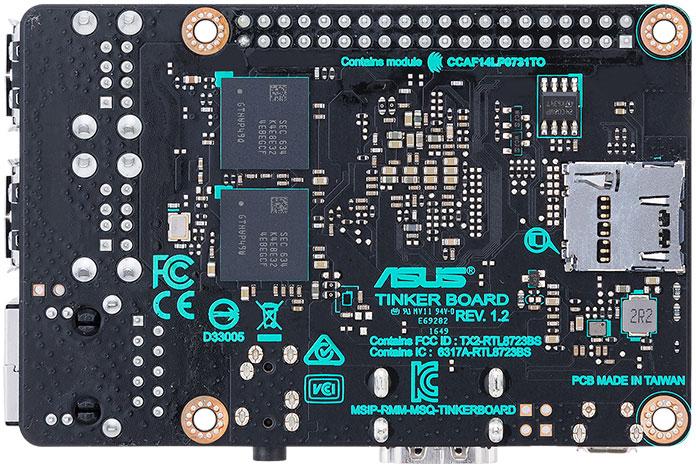Asus Brings Its Tinker Board To North America



Asus announced that its Tinker Board is now available in North America.
Previously available only overseas, the Asus Tinker Board is a single-board computer powered by a 1.8GHz Rockchip RK3288 quad-core processor and 2GB of dual-channel LPDDR3. The 85.60 x 56 x 21mm device features 1Gb Ethernet, a Mali-T764 GPU with HD/UHD video playback support, H.264/H.265 decoding, 192kHz/24-bit audio support, four USB 2.0 ports, Bluetooth 4.0, and built-in 802.11b/g/n WiFi.
Despite its credit card-sized package, the Asus Tinker Board packs as much power as many Chromebooks. Enterprising enthusiasts and hobbyists have made use of single-board computers for gaming emulators, robotics, car computers, HTPC media streaming, mini web browsers, file storage servers, cloud servers, home automation--the list goes on and on. All that power in such a tiny package means the possibilities to create personalized devices are endless. Think of it as a Raspberry Pi on steroids.
The included TinkerOS is a Linux distribution based on the latest Debian 9 core. The Debian-based TinkerOS provides a foundation for basic tasks such as web browsing, watching videos, and listening to music. The LXDE desktop environment includes an optimized Chromium web browser and Python and Scratch coding apps. It should be noted that the TinkerOS media player, co-developed with Rockchip, is required for hardware-accelerated 4K video playback.
The Asus Tinker Board is available now at Amazon and Micro Center with a suggested MSRP of $54.99.
| Header Cell - Column 0 | Asus Tinker Board |
|---|---|
| Processor | Rockchip RK3288 Cortex-A17 Quad-core 1.8GHz |
| GPU | ARM Mali-T764 equipped with H.264/H.265 hardware decoder |
| Display | Full-size HDMI 1.4 (supports up to 4K)15-pin MIPI DSI (supports up to HD) |
| Memory | Dual-channel LPDDR3 2GB |
| Storage | Micro SD card slot |
| Connectivity | RTL8211E-VB-CG GbE LANAW-NB177NF Wi-Fi 802.11 b/g/n & Bluetooth 4.0 with EDR |
| Audio | RTL ALC4040 Codec with 1 x 3.5mm audio jack with 192K/24bit audio |
| Camera Interface | 1 x 15-pin MIPI CSI slot for camera |
| USB | 4 x USB 2.0 ports |
| Internal Headers | 1 x 40-pin GPIO equipped header |
| Power | Micro USB |
| Operating System | TinkerOS (Debian) |
| Size | 85.60 x 56 x 21mm |
| Price | $54.99 |
Get Tom's Hardware's best news and in-depth reviews, straight to your inbox.
Steven Lynch is a contributor for Tom’s Hardware, primarily covering case reviews and news.
-
Tech_TTT Why not Snapdragon 835?Reply
The Raspberry Pi is low specs ..
and now this is low specs ..
we want top of the line ARM CPU board PLEASE -
cryoburner Reply19585528 said:Why not Snapdragon 835?
The Raspberry Pi is low specs ..
and now this is low specs ..
we want top of the line ARM CPU board PLEASE
The Snapdragon 835 apparently costs almost $50 on its own, so they clearly couldn't put something like that in a device around this price level. -
bit_user Reply
You'll do a bit better with one of these:19585528 said:we want top of the line ARM CPU board PLEASE
http://www.hardkernel.com/main/products/prdt_info.php?g_code=G145457216438
Still A53 cores, I know, but a fair bit faster than the Pi 3 and similarly priced.
http://www.96boards.org/products/
These are more expensive, but you can get:■8x A53:
http://www.96boards.org/product/hikey/
■2x A72 + 4x A53 + 4x A53:
http://www.96boards.org/product/mediatek-x20/
■4x A57 in the form of AMD's Opteron A1100:
http://www.96boards.org/product/cello/
AMD is supposed to release the K12, this year. No clue what socket it'll use. If it's big enough, maybe Naples'. Otherwise, it'd be cool if they went with AM4.
Anyway, I gave up on ARM, for the time being. I just bought an ASRock J4205-ITX to replace my Pi-based micro-server.
http://www.asrock.com/mb/Intel/J4205-ITX/index.us.asp
Sure, it burns more power than a Pi, but I can use a mainstream distro, I have a wide selection of cases (though I'd rather it were NUC/mini-STX form factor), and the graphics are fully-supported via both opensource and binary blob driver stacks. As for performance, it seems comparable to a similarly-clocked Core2 quad.
Maybe its replacement will be an ARM-based mini-ITX (or mini-STX). I thought it'd have happened by now, but I guess I was off by a couple years. -
bit_user Reply
To the extent it's a fairly standard Debian distro, yes. I'm running Samba on my 1st generation Pi. Also miniDLNA, for streaming (not quite fast enough for video, thus my upgrade).19585943 said:Can I do a samba server with TinkerOS? -
Tech_TTT Reply19586603 said:
You'll do a bit better with one of these:19585528 said:we want top of the line ARM CPU board PLEASE
http://www.hardkernel.com/main/products/prdt_info.php?g_code=G145457216438
Still A53 cores, I know, but a fair bit faster than the Pi 3 and similarly priced.
http://www.96boards.org/products/
These are more expensive, but you can get:■8x A53:
http://www.96boards.org/product/hikey/
■2x A72 + 4x A53 + 4x A53:
http://www.96boards.org/product/mediatek-x20/
■4x A57 in the form of AMD's Opteron A1100:
http://www.96boards.org/product/cello/
AMD is supposed to release the K12, this year. No clue what socket it'll use. If it's big enough, maybe Naples'. Otherwise, it'd be cool if they went with AM4.
Anyway, I gave up on ARM, for the time being. I just bought an ASRock J4205-ITX to replace my Pi-based micro-server.
http://www.asrock.com/mb/Intel/J4205-ITX/index.us.asp
Sure, it burns more power than a Pi, but I can use a mainstream distro, I have a wide selection of cases (though I'd rather it were NUC/mini-STX form factor), and the graphics are fully-supported via both opensource and binary blob driver stacks. As for performance, it seems comparable to a similarly-clocked Core2 quad.
Maybe its replacement will be an ARM-based mini-ITX (or mini-STX). I thought it'd have happened by now, but I guess I was off by a couple years.
I need it small and fast to use in DIY Robots Projects and DIY portable game consoles projects ... we need the fastest we can get. -
bit_user Reply
Fast ain't a problem. And small? No problem. It'll cost you, though.19587070 said:I need it small and fast to use in DIY Robots Projects and DIY portable game consoles projects ... we need the fastest we can get.
https://developer.nvidia.com/embedded-computing
In other news, the Goldmont-based Up^2 should start shipping in days: http://www.up-board.org/upsquared/
If you can trade some speed for size: http://www.up-board.org/upcore/
The original has been shipping for a while. Like Core, it's Silvermont-based: http://www.up-board.org/up/
For robotics, the x5-z8350 in Up and Up Core has 192 GFLOPS of fp32 compute power, making it probably the best tradeoff. Its cell phone-oriented CPU is also probably the most efficient. Sure, the Up^2 is faster, but you'll pay for it both in $ and in W.
Again, if you need to go cheaper, then the Odroid-C2 is worth a look. -
bit_user I almost got the Up^2 to replace my Pi. Then, I realized that for its price, I could put together a full system (except SSD) around the ASRock J4205-ITX and went that route. It's a shame, because I really wanted something smaller than mini-ITX, but at least I got a few hundred extra MHz and more features on that board.Reply -
Tech_TTT Reply19586023 said:19585528 said:Why not Snapdragon 835?
The Raspberry Pi is low specs ..
and now this is low specs ..
we want top of the line ARM CPU board PLEASE
The Snapdragon 835 apparently costs almost $50 on its own, so they clearly couldn't put something like that in a device around this price level.
I will gladly pay $30 more if they put this CPU instead of theirs :) -
Tech_TTT Reply19587324 said:
Fast ain't a problem. And small? No problem. It'll cost you, though.19587070 said:I need it small and fast to use in DIY Robots Projects and DIY portable game consoles projects ... we need the fastest we can get.
https://developer.nvidia.com/embedded-computing
In other news, the Goldmont-based Up^2 should start shipping in days: http://www.up-board.org/upsquared/
If you can trade some speed for size: http://www.up-board.org/upcore/
The original has been shipping for a while. Like Core, it's Silvermont-based: http://www.up-board.org/up/
For robotics, the x5-z8350 in Up and Up Core has 192 GFLOPS of fp32 compute power, making it probably the best tradeoff. Its cell phone-oriented CPU is also probably the most efficient. Sure, the Up^2 is faster, but you'll pay for it both in $ and in W.
Again, if you need to go cheaper, then the Odroid-C2 is worth a look.
Thanks for the info , I like the nvidia board . :)